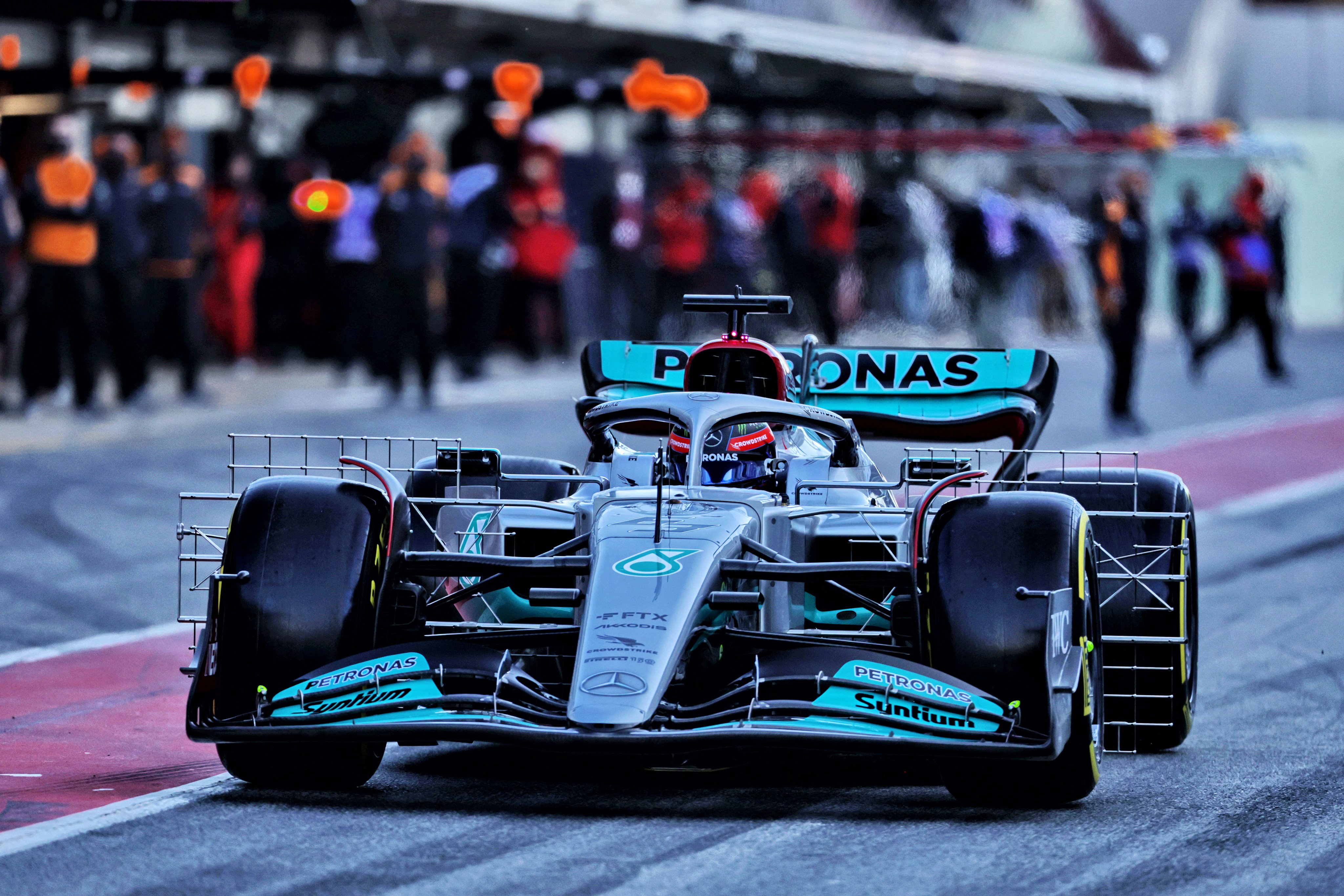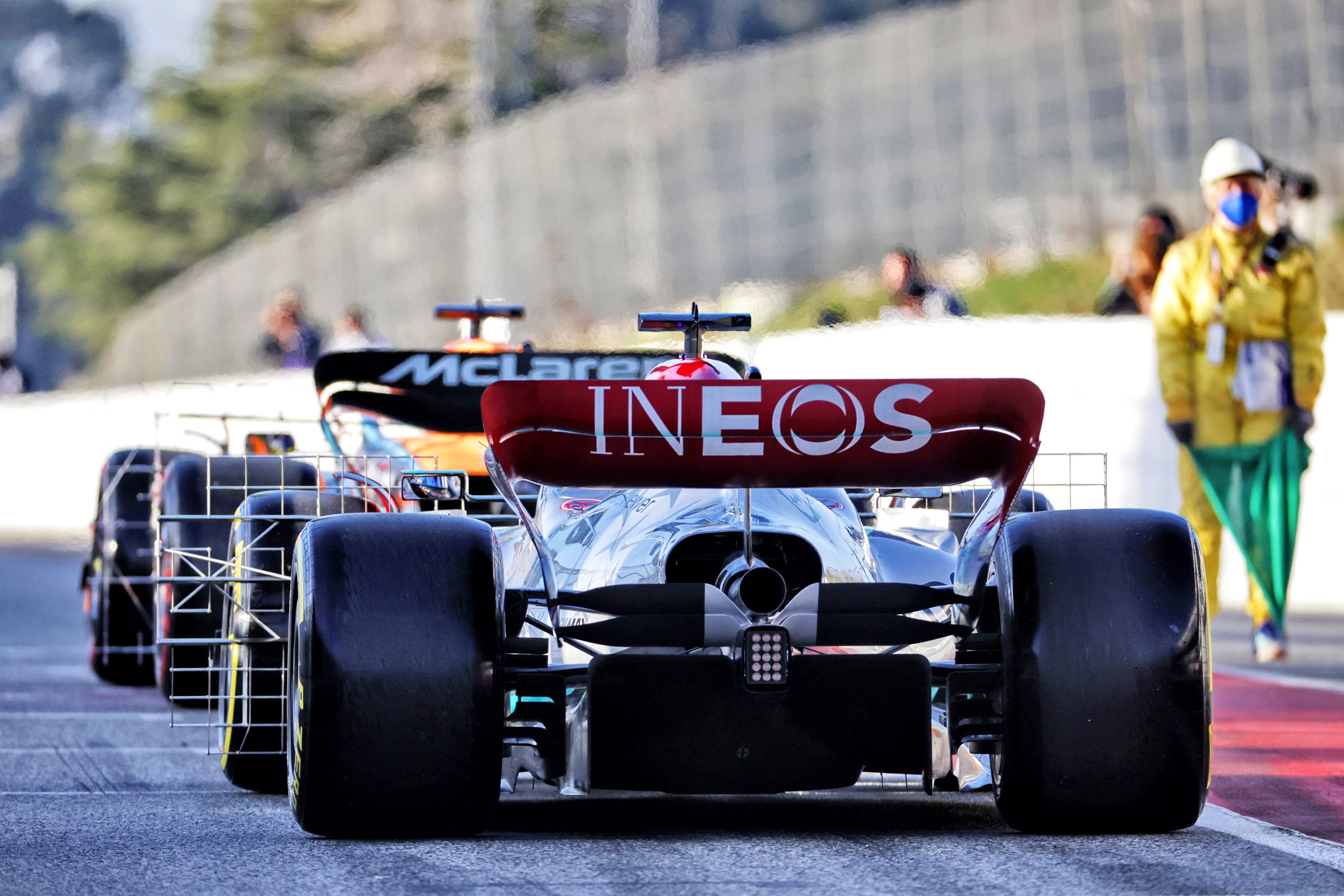the only one currently running inward pointing vortex generators on the wing adjusters. this means they want to generate more vortex
- Login or Register
No account yet? Sign up
It certainly is unique and strange in so many ways, especially when comparing to other cars so far. Something feels uncanny, I had the same feeling in 2016 when they presented their car. I just hope the result is the same.pierrre wrote: ↑22 Feb 2022, 21:25the only one currently running inward pointing vortex generators on the wing adjusters. this means they want to generate more vortex
https://www.mercedesamgf1.com/content/d ... 299058.JPG
I think almost everything will depend on how well the floor works!
Hi. What do you mean by the rear tyre suffered a lot?Vanja #66 wrote: ↑22 Feb 2022, 21:04Hello everyone, after doing the F1-75 sidepods simulation, I also did the W13 as well. To keep everything in the same place, I decided to post it in the same thread here --> viewtopic.php?p=1035377#p1035377
Just a shor summary for those who might not want to read trough all of it, these sidepods are super tiny and super low drag but the rear tyre suffered a lot in this simulation and overall the car generated more downforce compared to the other sidepod design, but was also less aerodinamically efficient.
https://i.ibb.co/R78VY64/comp1-iso-details.jpg
As he explained it in the mentioned post, he means rear tires drag. Ferrari's vertical flat sidepods creates a low pressure area in front of the rear tires which reduces the rear tires drag . Kyle.engineers also explained this in his youtube video about f1-75.ringo wrote: ↑22 Feb 2022, 22:10Hi. What do you mean by the rear tyre suffered a lot?Vanja #66 wrote: ↑22 Feb 2022, 21:04Hello everyone, after doing the F1-75 sidepods simulation, I also did the W13 as well. To keep everything in the same place, I decided to post it in the same thread here --> viewtopic.php?p=1035377#p1035377
Just a shor summary for those who might not want to read trough all of it, these sidepods are super tiny and super low drag but the rear tyre suffered a lot in this simulation and overall the car generated more downforce compared to the other sidepod design, but was also less aerodinamically efficient.
https://i.ibb.co/R78VY64/comp1-iso-details.jpg
The only thing we must keep in mind as has been mentioned before, is that we don't have a complete view of the packages as a whole.timoth wrote: ↑22 Feb 2022, 22:21As he explained it in the mentioned post, he means rear tires drag. Ferrari's vertical flat sidepods creates a low pressure area in front of the rear tires which reduces the rear tires drag . Kyle.engineers also explained this in his youtube video about f1-75.ringo wrote: ↑22 Feb 2022, 22:10Hi. What do you mean by the rear tyre suffered a lot?Vanja #66 wrote: ↑22 Feb 2022, 21:04Hello everyone, after doing the F1-75 sidepods simulation, I also did the W13 as well. To keep everything in the same place, I decided to post it in the same thread here --> viewtopic.php?p=1035377#p1035377
Just a shor summary for those who might not want to read trough all of it, these sidepods are super tiny and super low drag but the rear tyre suffered a lot in this simulation and overall the car generated more downforce compared to the other sidepod design, but was also less aerodinamically efficient.
https://i.ibb.co/R78VY64/comp1-iso-details.jpg
It seems so counterintuitive that these massive sidepods produce less drags. But when you consider that tires were responsible for about 40% of the total drag of the car until last year and with the new cars, not only the diameter of the tires increased, but also the bodywork of the new cars produce less drag, so you expect the tires be responsible for more than 40% of the drag. So focusing to reduce the drag created by tires may not be a bad choice actually.
Absolutely, maybe Mercedes uses other tricks to reduce rear tire drags, maybe they produce much more downforce, but we don't know and as vanja himself said, the models are basic and are just used to compare different concepts.dans79 wrote: ↑22 Feb 2022, 22:32The only thing we must keep in mind as has been mentioned before, is that we don't have a complete view of the packages as a whole.timoth wrote: ↑22 Feb 2022, 22:21As he explained it in the mentioned post, he means rear tires drag. Ferrari's vertical flat sidepods creates a low pressure area in front of the rear tires which reduces the rear tires drag . Kyle.engineers also explained this in his youtube video about f1-75.
It seems so counterintuitive that these massive sidepods produce less drags. But when you consider that tires were responsible for about 40% of the total drag of the car until last year and with the new cars, not only the diameter of the tires increased, but also the bodywork of the new cars produce less drag, so you expect the tires be responsible for more than 40% of the drag. So focusing to reduce the drag created by tires may not be a bad choice actually.
We have to be careful how we interpret CFD images. Yes there is more pressure in front of the rear tyre. But the drag in front of the tyre is not the priority of the side pod designs.timoth wrote: ↑22 Feb 2022, 22:21As he explained it in the mentioned post, he means rear tires drag. Ferrari's vertical flat sidepods creates a low pressure area in front of the rear tires which reduces the rear tires drag . Kyle.engineers also explained this in his youtube video about f1-75.ringo wrote: ↑22 Feb 2022, 22:10Hi. What do you mean by the rear tyre suffered a lot?Vanja #66 wrote: ↑22 Feb 2022, 21:04Hello everyone, after doing the F1-75 sidepods simulation, I also did the W13 as well. To keep everything in the same place, I decided to post it in the same thread here --> viewtopic.php?p=1035377#p1035377
Just a shor summary for those who might not want to read trough all of it, these sidepods are super tiny and super low drag but the rear tyre suffered a lot in this simulation and overall the car generated more downforce compared to the other sidepod design, but was also less aerodinamically efficient.
https://i.ibb.co/R78VY64/comp1-iso-details.jpg
It seems so counterintuitive that these massive sidepods produce less drag. But when you consider that tires were responsible for about 40% of the total drag of the car until last year and with the new cars, not only the diameter of the tires increased, but also the bodywork of the new cars produce less drag, so you expect the tires be responsible for more than 40% of the drag. So focusing to reduce the drag created by tires may not be a bad choice actually.
Why does it?pierrre wrote: ↑22 Feb 2022, 21:25the only one currently running inward pointing vortex generators on the wing adjusters. this means they want to generate more vortex
https://www.mercedesamgf1.com/content/d ... 299058.JPG
They have several devices on the car that aren't on the CFD model used in the analysis. Likewise Ferrari.timoth wrote: ↑22 Feb 2022, 22:39Absolutely, maybe Mercedes uses other tricks to reduce rear tire drags, maybe they produce much more downforce, but we don't know and as vanja himself said, the models are basic and are just used to compare different concepts.dans79 wrote: ↑22 Feb 2022, 22:32The only thing we must keep in mind as has been mentioned before, is that we don't have a complete view of the packages as a whole.timoth wrote: ↑22 Feb 2022, 22:21
As he explained it in the mentioned post, he means rear tires drag. Ferrari's vertical flat sidepods creates a low pressure area in front of the rear tires which reduces the rear tires drag . Kyle.engineers also explained this in his youtube video about f1-75.
It seems so counterintuitive that these massive sidepods produce less drags. But when you consider that tires were responsible for about 40% of the total drag of the car until last year and with the new cars, not only the diameter of the tires increased, but also the bodywork of the new cars produce less drag, so you expect the tires be responsible for more than 40% of the drag. So focusing to reduce the drag created by tires may not be a bad choice actually.
If the vortex device is pointing inboard, then flow isn't inboard. Or at least it's unlikely. You want the VG to be "across" the flow in order for it to build up a pressure difference across it. The pressure difference is what causes the vortex as the air flows up and over from the high pressure side to the low pressure side.Mchamilton wrote: ↑22 Feb 2022, 23:24Why does it?pierrre wrote: ↑22 Feb 2022, 21:25the only one currently running inward pointing vortex generators on the wing adjusters. this means they want to generate more vortex
https://www.mercedesamgf1.com/content/d ... 299058.JPG
Surely it just means that is the genral direction of flow in that region.





